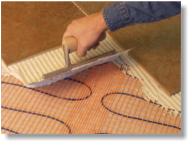
 What is Radiant Heat?
What is Radiant Heat?
 How It Works
How It Works
 Where It Belongs
Where It Belongs
 Snowmelting Systems
Snowmelting Systems
|
|
Robert Shewokis Fuels Inc. is an authorized dealer of Heatway, selling and servicing
Radiant Heating Systems
 
|
|
What is Radiant Heat?
Energy brodcasts at the speed of light from a heated surface, usually the floor. Every object
in the room absorbs this warming energy while the room temperature stays lower than with
forced air. Although the room temperature does not exceed 85 degrees F, this is all
you need to evenly distribute heat where you need it - without wasting it on the ceiling.
Comfort is King!
- Your circulation will improve because your feet are warm. Chairs and walls keep warm
without cold spots or drafts.
[
Top of page ]
How It Works
Heatway Radiant Heating systems are either electric or hydronic
 Electric Electric
Electric systems use a heating elements that are embedded in your the floor and energized by
alternating either 120 or 240 volt current from your the breaker box. The warm heating elements
conduct heat to your the floor surface which then broadcasts energy into the room.

These systems use simple electronic controls and may offer a floor sensor and optional set back
or timer features.
By code, systems must be protected by a ground fault circuit interrupt device. More advanced
features include whole-load carrying, fully braided grounded armor from one end to the other,
fully braided grounded armor power leads and shielding. In addition, the unique wire design
enables the mats to emit less than one mili-gaus of EMF (electromagnetic field).
|
|
 Hydronic Hydronic
Hydronic systems use tubing embedded in the floor to carry heated fluids that conduct warmth
to the surface of the floor where it then broadcasts energy to your the room.
A radiant zone is a floor area controlled by one thermostat and served by a manifold which distributes
the flow of warm fluids to the individual circuits of tubing within the zone.
Supply pipes carry heated fluids to the supply manifold and then return it from the return
manifold to the heat source; usually a boiler. Boilers can heat water with natural gas, propane,
electricity or wood.
 Most hydronic systems use water which may be treated to improve its resistance to freezing or
corrosion of ferrous system components.
Most hydronic systems use water which may be treated to improve its resistance to freezing or
corrosion of ferrous system components.
Hydronic systems are closed loop: the same fluid is heated and then reheated. Advanced systems
may include valves or injection loops to precisely control temperatures in each zone, and
outdoor resets to anticipate sudden weather changes.
Hydronic systems are also used with antifreeze solutions to melt snow and ice from walkways,
parking lots and streets. They are more commonly used in commercial and whole house heating
projects while electric systems are more commonly used in smaller or "spot warming" applications.
|
Heatway Radiant Heating Systems are comprised of 3 parts...
 Heat Source - The heat source can be any device using any kind of fuel to
make water warm. Usually these are 'boilers' burning a low-cost fuel or electronic controls.
Heat Source - The heat source can be any device using any kind of fuel to
make water warm. Usually these are 'boilers' burning a low-cost fuel or electronic controls.
 Pumps & Controls - Heated water is directed to its destination with
pumps and controls that are supported by various valves and gauges.
Pumps & Controls - Heated water is directed to its destination with
pumps and controls that are supported by various valves and gauges.
 Radiant Zone - The radiant zone is made up of Heatway hose circuits joined
together by supply and return manifolds. It is at this point where pumped water
will give up much of its energy and be returned to its source for re-heating.
Radiant Zone - The radiant zone is made up of Heatway hose circuits joined
together by supply and return manifolds. It is at this point where pumped water
will give up much of its energy and be returned to its source for re-heating.
[
Top of page ]
Where it Belongs
Almost any floor surface can be radiant....
[
Top of page ]
Snowmelting Systems
 |
Class I - Residential/Light Commerical
Recommended for residential and light commercial walkways, driveways, entrances, etc. It
permits the entire surface to be covered with snow while the snow is falling , although melting
is occurring under the blanket of snow. The snow will gradually melt after the snowfall ends
(A typical design might be 9"-12" o.c. Entran spacing with a load of 75-125 BTU/sq.ft.)
|
 |
Class II - Heavy Commerical
Recommended for heavier commerical applications, such as docks, ramps, entrances, driveways, etc.,
It permits 50% of the surface area to be covered with snow during the snowfall event. The
remaining snow will gradually melt after the snowfall ends.
(A typical design might be 8"-9" o.c. Entran spacing with a load of 125-175 BTU/sq.ft.)
|
 |
Class III - Institutional/Industrial
Recommended for hospital emergency entrances, helicopter pads, high-priority aprons,
loading areas, runways, etc. This class melts all of the snow at maximum snowfall
amounts as the snow falls.
(A typical design might be 6"-9" o.c. Entran spacing with a load of 175-250 BTU/sq.ft.)
|
[
Top of page ]
For additioanl information on Heatway Radiant Heating Systems, please
contact us
or call
(570) 277-6168.
|
Home |
About Us |
Services |
Products |
Specials |
Contact Us
Copyright � - 2001 Robert Shewokis Fuels Inc.
400 Valley St. New Philadelphia, PA 17959
Phone: (570) 277-6168 | Fax: (570) 277-6449
"We're Your Pipeline on Wheels"
|
|